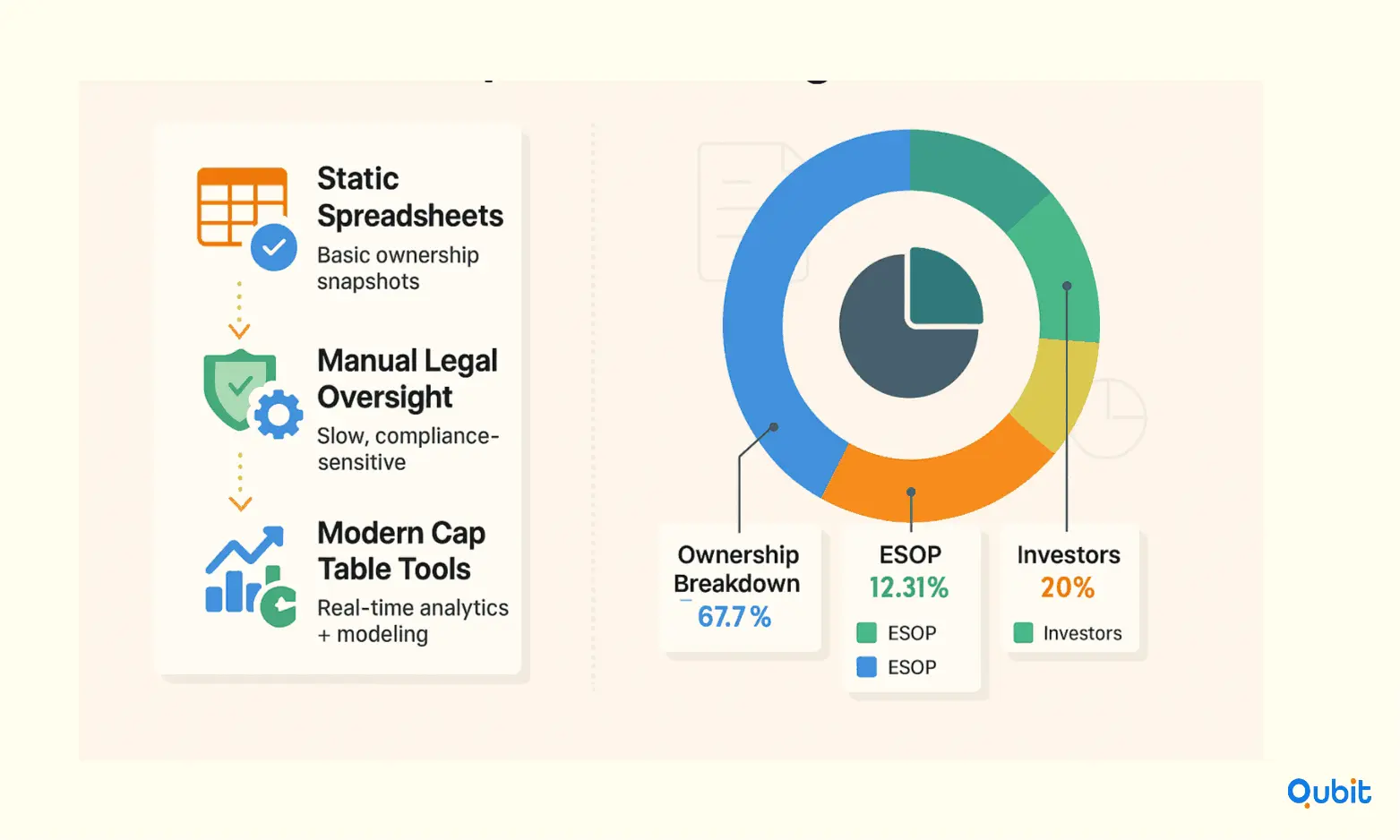A well-structured cap table is more than just a record of ownership; it’s a vital tool for managing equity dynamics as your startup evolves. Post-investment, the cap table becomes even more critical, influencing decision-making, future funding rounds, and stakeholder relationships.
Understanding how to maintain balance in equity distribution while accommodating new investors is essential. Your examination of cap table management ties seamlessly into concepts found in how to do startup outreach for investors, where broader engagement strategies are discussed alongside equity allocation frameworks.
This blog will explore the nuances of managing cap tables after an investment round, offering insights into best practices, potential pitfalls, and the tools that can simplify the process. Let’s dive in!
Understanding Cap Table Management: Definition and Overview
Cap table management plays a pivotal role in defining the ownership structure of a company. A capitalization table, or "cap table," is a detailed record that outlines equity distribution, shareholder rights, and valuation metrics. It serves as a foundational tool for startups and established businesses alike, offering clarity on who owns what and how much within the organization.

Beyond ownership, cap tables are essential for ensuring regulatory compliance, maintaining transparency in investor relations, and guiding strategic decision-making. For example, founders typically hold the majority stake initially, such as 67.7%, while employee stock option plans (ESOPs) might account for 12.31%, and investors collectively hold around 20% after a funding round. These percentages highlight how cap tables reflect the evolving dynamics of equity distribution as companies grow.
The traditional static cap table is rapidly being replaced by dynamic, real-time analytic tools. These advanced systems integrate data-driven insights, enabling businesses to adapt quickly to changes in ownership structures or valuation metrics.
Cap table management is not just about tracking numbers; it’s about empowering businesses to make informed decisions. Whether negotiating terms with investors or planning future funding rounds, a well-maintained cap table is indispensable for sustainable growth.
Effective Cap Table Construction Techniques
Creating a well-structured cap table is essential for tracking ownership and ensuring transparency in equity distribution. Two primary approaches dominate this process: traditional Excel templates and modern, dedicated software solutions. Each method offers distinct advantages and challenges, making it crucial to choose the right tool based on your business needs.
Excel Templates: A Familiar Starting Point
Excel templates remain a popular choice for startups and small businesses due to their accessibility and low cost. They allow users to manually input data and utilize basic formulas to track ownership distribution. For example, you can use Excel Sheet Templates for Cap Tables to simulate scenarios like a new funding round. However, the manual nature of Excel can lead to errors, especially as the cap table grows in complexity. Regular updates and compliance tracking also require significant time and effort.
Dedicated Software: Automation and Scalability
For businesses managing intricate cap tables, dedicated software solutions provide a more robust alternative. These platforms offer automation, real-time updates, and integrated compliance tools, significantly reducing the risk of human error. Tools like Cap Table Software enable automatic share count updates and streamlined compliance tracking, while platforms such as the SeedBlink Equity Management Platform support scenario modeling for multiple fundraising rounds. These features make dedicated software ideal for scaling businesses.
Choosing the Right Approach
The decision between Excel and specialized software depends on your company’s stage and complexity. While Excel is suitable for early-stage startups with straightforward equity structures, transitioning to cloud-based platforms becomes essential as scalability and accuracy take precedence.
Understanding the nuances of cap table construction ensures informed decision-making and smoother equity management.
Optimizing Founders' Equity and ESOP Planning
Establishing a fair equity split among founders is a cornerstone of startup success. When equity is distributed thoughtfully, it fosters collaboration and ensures balanced contributions, reducing the likelihood of disputes that can derail progress. Research highlights that nearly 90% of startups utilize equity-based compensation strategies, underscoring its importance in building a cohesive team.
Employee Stock Option Plans (ESOPs) are equally vital for attracting and retaining top talent. By aligning employees' interests with the company’s growth, ESOPs create a shared sense of ownership and commitment. Early implementation of these plans can significantly enhance a startup’s ability to recruit skilled professionals who are invested in long-term success.
Balancing founders' equity and designing robust ESOPs are not just strategic moves, they are essential steps in building a resilient and motivated team. By addressing these aspects early, startups can set a strong foundation for sustainable growth.
Strategies for Managing Expanding Cap Tables
As startups grow, their cap tables often become increasingly complex, reflecting multiple fundraising rounds and a broader investor base. Managing this complexity is crucial to maintaining clarity in ownership, ensuring compliance, and avoiding excessive dilution.
1. Understand Regulatory Thresholds
A cap table with more than 30 stockholders can introduce significant compliance challenges. Surpassing this threshold may complicate reporting obligations and increase administrative overhead. Staying informed about regulatory limits helps founders anticipate and mitigate these risks before they escalate.
2. Consolidate Small Shareholders
Fragmented ownership can obscure decision-making and create inefficiencies. Consolidating small shareholders into larger, more manageable groups is one way to streamline the cap table. This approach not only simplifies communication but also reduces the administrative burden associated with tracking numerous minor stakeholders.
3. Set Minimum Investment Thresholds
Establishing a minimum investment threshold—such as $50,000—can help control dilution and maintain a cleaner cap table. By setting this floor, startups can attract serious investors while minimizing the administrative complexity of managing numerous small investments.
4. Proactively Address Dilution
Dilution is an inevitable part of fundraising, but its impact can vary significantly depending on the structure of the investor base. For example, the dilution effect of adding one large stockholder differs greatly from adding ten smaller investors. By modeling these scenarios in advance, founders can make informed decisions that align with their long-term goals.
By implementing these strategies, startups can maintain clarity and control as their cap tables expand, ensuring a strong foundation for future growth.
Best Practices to Ensure Accurate Cap Table Management
Maintaining an accurate cap table is essential for businesses to make informed decisions and remain compliant with regulations. A well-managed cap table provides clarity on ownership structures, supports strategic planning, and ensures smooth operations during funding rounds.
1. Regular Updates and Verification
Frequent updates to your cap table are critical. Every equity transaction—whether issuing new shares, granting stock options, or transferring ownership—should be recorded promptly. Regularly verifying the accuracy of this data ensures that your cap table reflects the current state of ownership. This practice not only aids in decision-making but also helps avoid compliance risks tied to outdated or incorrect records.
2. Centralize Equity Documentation
As companies grow, managing equity documentation can become increasingly complex. Centralizing all equity-related records in a single platform minimizes errors and streamlines processes. By consolidating data, businesses can reduce discrepancies and ensure that all stakeholders have access to consistent information.
3. Proactive Stakeholder Communication
Transparent communication with stakeholders is vital for cap table management. Keeping investors, employees, and other stakeholders informed about changes in ownership or equity ensures alignment and prevents misunderstandings. This proactive approach also prepares businesses for future funding rounds by fostering trust and collaboration.
Accurate cap table management is not just about record-keeping, it’s about creating a foundation for growth and compliance.
Advanced Strategies for Managing Complex Cap Tables
Handling intricate cap tables requires innovative solutions to ensure clarity and adaptability. Two advanced techniques, nominee structures and tailored stockholder agreements, offer effective ways to simplify shareholder management while preserving legal integrity.
1. Streamlining with Nominee Structures
Nominee structures consolidate minor shareholders under a single entity, reducing the number of individual entries on the cap table. This approach not only simplifies administrative tasks but also enhances decision-making efficiency by minimizing the need for extensive shareholder consultations. For companies with numerous small investors, nominee structures provide a practical way to maintain order without compromising shareholder rights.
2. Customizing Stockholder Agreements
Tailored stockholder agreements allow businesses to address unique challenges specific to their operations or growth stage. These agreements can include provisions for voting rights, transfer restrictions, or dividend policies, ensuring flexibility while safeguarding the company’s interests. By customizing agreements, companies can align shareholder expectations with long-term strategic goals, fostering a more cohesive ownership structure.
Both strategies offer a balance between simplicity and adaptability, empowering businesses to manage complex cap tables effectively.
Legal & Compliance Essentials in Cap Table Management
Effective cap table management hinges on a solid understanding of legal frameworks and compliance standards. Missteps in equity calculations or documentation can result in costly legal disputes and regulatory penalties, making accuracy a non-negotiable priority.
One critical aspect of compliance is maintaining precise and up-to-date records. Errors in tracking ownership stakes or issuing shares can lead to significant financial and legal repercussions, particularly during audits or funding rounds. A realistic approach to post-investment record keeping is enhanced by examining legal structures for startup investments, highlighting how foundational legal documentation supports cap table accuracy.
Proactive legal measures, such as regular audits and systematic integration with regulatory reporting, are equally vital. These practices ensure that the cap table aligns with both internal policies and external requirements, minimizing the risk of non-compliance. Moreover, ongoing compliance fosters trust among stakeholders, from investors to employees, by demonstrating a commitment to transparency and accountability.
By prioritizing legal and compliance essentials, businesses can safeguard their financial health and reputation, ensuring smoother operations and stronger investor relationships.
Cap Table Management Software Solutions
Managing cap tables can be a daunting task, especially as businesses grow and equity structures become more complex. Modern cap table management software offers a streamlined solution, combining automation, real-time updates, and advanced compliance features to simplify the process.
Dedicated tools like the Cake Cap Table Management Tool are designed to enhance accuracy and reduce manual errors. With built-in templates, users can quickly draft share allocations and notify investors in real time, ensuring faster and more efficient communication. These features not only save time but also minimize the risk of calculation mistakes that could lead to costly compliance issues.
Interactive dashboards and AI-powered simulations further elevate strategic planning. By visualizing complex equity scenarios, businesses can make informed decisions before finalizing investment terms.
Automation plays a pivotal role in simplifying cap table management. From tracking ownership changes to generating reports, these tools eliminate repetitive tasks, allowing teams to focus on strategic priorities. The result is a more transparent and efficient equity management process that supports growth and investor confidence.
By adopting these software solutions, businesses can transform cap table management from a tedious chore into a streamlined, strategic advantage.
Conclusion
Effective cap table management is more than just a financial exercise; it’s a cornerstone of your startup’s success. From understanding the basics of cap table construction to implementing optimization and management strategies, every step plays a pivotal role in ensuring transparency and legal compliance. By adopting best practices and integrating technological solutions, you can streamline processes and maintain accuracy, which is essential for building investor confidence and securing future funding rounds.
Proactive management of your cap table not only simplifies decision-making but also positions your startup as a trustworthy and well-organized entity in the eyes of stakeholders.
If you’re ready to take the next step in your growth journey, we at Qubit Capital are here to help. Contact us to explore tailored funding solutions through our Fundraising Assistance service and empower your startup’s future.
Key takeaways
- Accurate cap table management is critical for compliance and investor confidence.
- Automated tools streamline complex equity calculations and improve transparency.
- Regular updates and detailed record-keeping prevent dilution and ensure accuracy.
- Effective stakeholder communication is essential to manage growth and regulatory challenges.
- Tailored legal and compliance strategies safeguard against potential disputes.
Frequently asked Questions
What is a cap table and why is it important?
A cap table is a summary of a company’s equity ownership, detailing shareholder stakes. It is essential for tracking equity distribution and ensuring regulatory compliance.






